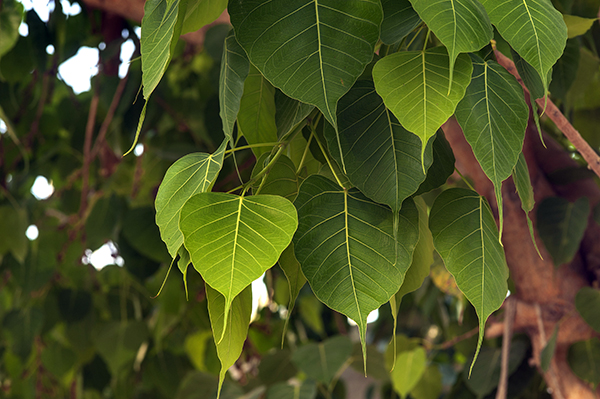Ashwattha ( Ficus religiosa)
Ashwattha is known as peepal in Hindi and sacred fig in English. It belongs to family moraceae or kashay skandh in Ayurveda. It is a species of fig, native to the Indian subcontinent and Indochina. This tree is sacred in Indian tradition. In the Bhagavad Gita, Krishna says: “Among trees, I am the Ashvattha.” It is believed that the three main gods reside in this tree, Brahma the roots, Vishnu the trunk, and Shiva the leaves. In Buddhism, Buddha achieved enlightenment under the bodhi tree. Ashwattha is considered to be the largest oxygen provider, along with neem and tulsi. It provides oxygen even after sunset.
Plant description: This tree is deciduous, up to 30 meter high, bark is grey and smooth. Exudation is milky. The leaves are shiny, thin, heart shaped and bear 5–7 veins. Male, female and gall flowers are enclosed in axillary, sessile, globose figs. Fruits are small, about half inch in diameter and circular in shape. When raw, it is of green color and turns black when it is ripe. The tree bears fruits in summer and the fruits get ripened by rainy season.
Ayurvedic pharmacology: Guna-Guru, Ruksha Ras-Kashay, Madhur Vipak-Katu Virya-Shit Dosha Karma-Kaphapitta Shamak
Chemical composition: The stem bark contains phenols, tannins, steroids, alkaloids, flavonoids, and vitamin K. Root bark has β-sitosteryl-D-glucoside. Leaves and fruits contain carbohydrate, protein, lipid, calcium, sodium, potassium, phosphorus, campestrol, stigmasterol and isofucosterol .The crude latex shows the presence of a serine protease, named religiosin.
Therapeutically useful parts: Bark, leaves, shoots, fruits and seeds
Therapeutic uses: Bark is aphrodisiac and is also used in gonorrhoea, diarrhoea, dysentery, haemorrhoid and burns. Leaves and tender shoots are purgative, used in wound healing and skin diseases. Fruits are used in asthma, as a laxative and in haemorrhoids. Seeds are laxative. Latex is used in haemorrhages and inflammations.
Dr.Pratibha Mamgain, Dept. of Ayurvedic Medicine

